Well, you know how Gary and I like to walk around wherever we visit and Avalon is no exception. Walking through a town gives us a great feeling for the town. We get to see lots of out-of-the way places, the places that locals visit and inhabit. We began the day with a walk up to the Wrigley Mansion which is now known as Mt Ada with a 6-room B&B - with the best view on the island. It is also on the Register of Historic Places. To get there we found some steps leading from one level to the next (love those steps. Note the two levels here with Gary on the second level).
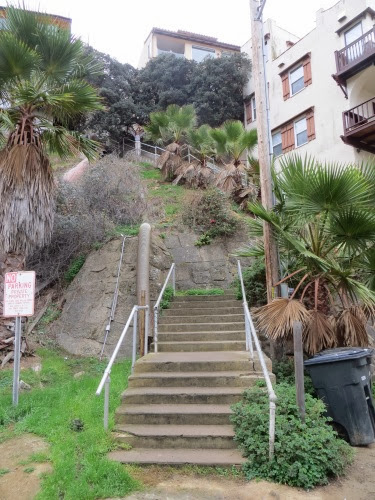
and found ourselves walking along one street, looking out over the rooftops of the houses on the street below us.
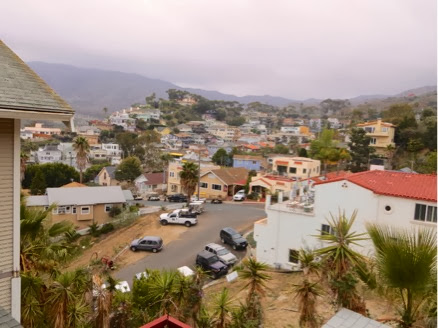
In fact, some of these homes had decks which we could access from our ‘road’. Middle Road it was called. The architecture on Avalon varies from wood frame to colorful Catalina tile. Lots of white and pastel homes with red tile roofs. Built on a small valley with steep sides, it looks like a Mediterranean village set off by the blue of the ocean. We found some new buildings going up and some repairs going on. I’m thinking that if you want to work on homes, you need to like heights.
We found some lots on a steep slope that were being offered for sale - for between $950,000 to $1,200,000. But, who wouldn’t want a home in Avalon?
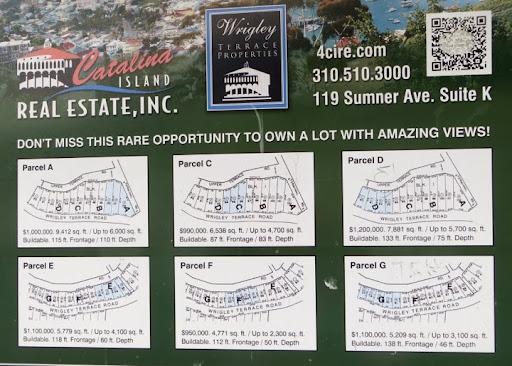
Here’s a view of these ‘buildable’ lots (as the sign called them). I’m not so sure this flatlander from Iowa would call them ‘buildable’. Here’s a picture from level with the slope. You can barely see Gary standing on the top of the lot on the road and the lower road is in the lower right of the picture. Now I realize that this is normal in towns built in valleys but I like to sleep in a bed on terra firma, not cantilevered out over a 45 degree slope.
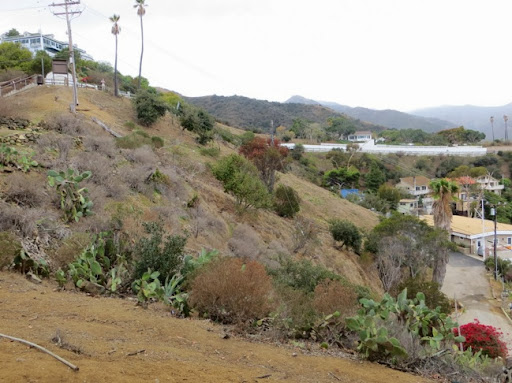
And, here’s a view from the Casino across the Avalon valley. The ‘buildable’ lots are between the white railing along the upper road and the 3-story home below.
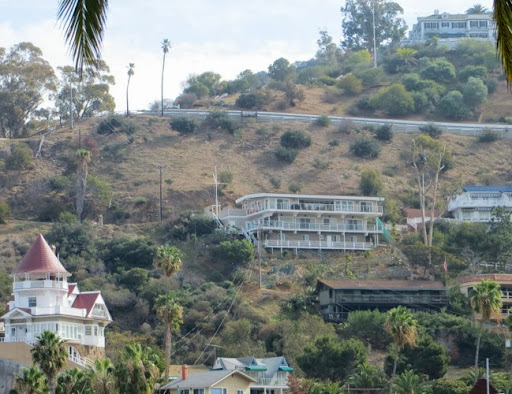
We walked higher up the slope taking in the gorgeous views. Then, thankfully, we began our climb back down the cliff. Below us we found the ‘guts’ of the town: the lumber yard, the electric plant, the warehouses, the desalination plant, etc. All hidden around a cove away from the touristy sections of the town. Yep, Gary and I like to see the out-of-the-way places.
At 12:30 we toured the Casino on a ‘Behind the Scenes’ Tour. Our guide knew everything about the Casino and related them all but he has been giving this tour way too often (4 times a day). He had rote phrases and, at one time, repeated something he had told us 10 minutes earlier word for word. We enjoyed the tour and seeing the insides of the Casino but his delivery was a bit stale.
Catalina has been the property of the Wrigley family since 1919, when William Jr., founder of the gum company, bought it for some $3 million. Before that the island was variously an Indian settlement, a Mexican colony and a way station for smugglers. It was discovered in 1542 by Juan Rodriguez Cabrillo, a Portuguese sailing from Mexico under the Spanish flag, then rediscovered by Sebastian Vizcaíno in 1602 and named Santa Catalina. For the next couple of centuries it was inhabited only by wild animals, primitive Indians and occasional groups of Spanish explorers. In the early 1800s the hunters and traders began arriving. Russian expeditions came down to hunt otter along the east, or windward, coast, and American fur traders swapped trinkets for skins with the Indians. The original inhabitants of the island, the Indians, were decimated by the diseases brought by the white man and shipped off to the mainland for conversion and for ‘volunteer’ work on missions. The American ownership of the island began in the late 1800’s with several failed attempts at settlement before Wrigley bought the island.
The Wrigley’s sold 88% of Catalina to the Catalina Conservancy in 1979. The Conservancy is now responsible for the sustainability and maintenance of the island. And, it the Conservancy which controls access to the interior and is trying to restore it to its original biodiversity.
THE CASINO
One of Wrigley’s greatest buildings on the island was the Casino. Aha, you say, gambling. Nope, absolutely no gambling. ‘Casino’ means ‘gathering place’ in Italian and that is how it was designed: there’s a theater on the main level (the first designed for talking pictures) and a 20,000 sq. ft. ballroom on the top which can hold 3000 couples dancing. And, did they ever dance. Most of the large dance bands of the 40’s and 50’s played here to large crowds. At one point Kay Kyser and his band played while 6200 danced, all brought over to the island on the steamers. Today it also serves as the islands civil defense shelter with enough space to hold the entire island’s population and enough food for 2 weeks.
Here it the inside of the theater. Beautiful design but what you can’t see is the acoustics which are so good that a person can stand on the stage and be heard throughout the theater. Our guide stood in the middle of the aisle and it sounded as if he were speaking through a microphone. The acoustics were so good that they have been replicated many times, most famously in Radio City Music Hall. The paintings all around the inside are of the history of Avalon. Note the hat ‘racks’ on the bottom of each seat in the theater.
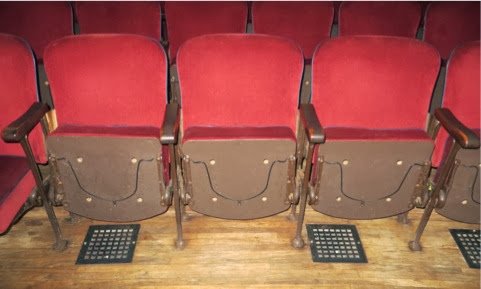
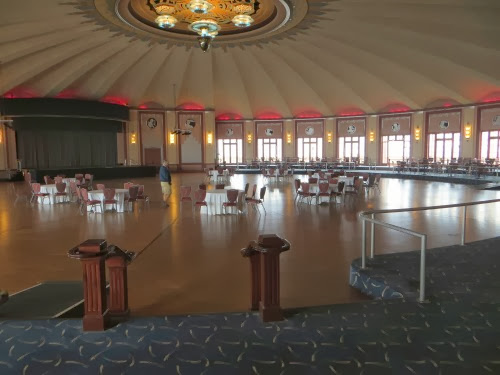
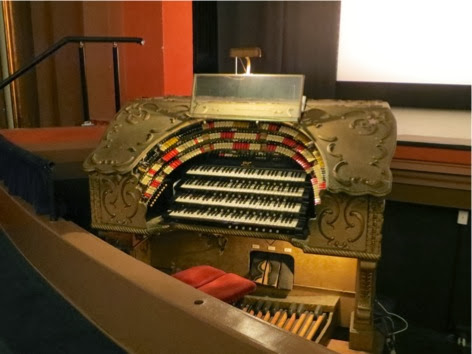
After we toured the Casino, we waked through the museum below. Here we found out about the Duke, Marilyn Monroe and other historical information about Avalon.
THE DUKE OF CATALINA
Back to the Way Back Machine - once when Deb and I managed to get into town, we saw the iconic character of Avalon, the Duke. He wore only a swim suit, was bald with an earring in one ear had had a barrel chest, from years of swimming. We asked around and found out that he was the ‘Duke of Catalina’. And that’s all we knew then but he was an interesting person and added to the aura of Avalon.
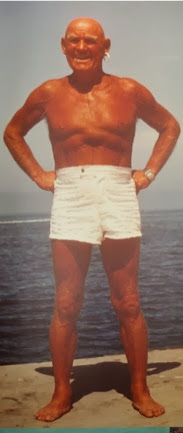
For many years he was the official greeter in Avalon and greeted people coming off the steamers and ferries with a hearty smile and a ‘Hi Naybor.’
NORMA JEAN BAKER
 Many movie starts have been in Avalon for long stretches of time, some still have a home here. But one of the most famous movie stars associated with the island is Marilyn Monroe. As Norma Jean Baker, she actually lived on the island before she was ‘discovered’ and actually worked at Lloyd’s, a candy and ice cream shop. She moved to Catalina in 1943 as a teenage bride when her husband Jim Dougherty, whom she married to escape life in foster care, was sent to the island by the merchant marines.
Many movie starts have been in Avalon for long stretches of time, some still have a home here. But one of the most famous movie stars associated with the island is Marilyn Monroe. As Norma Jean Baker, she actually lived on the island before she was ‘discovered’ and actually worked at Lloyd’s, a candy and ice cream shop. She moved to Catalina in 1943 as a teenage bride when her husband Jim Dougherty, whom she married to escape life in foster care, was sent to the island by the merchant marines.
She eventually divorced Dougherty and moved to the mainland where the rest is well-known history.
MOVIES
Have you ever seen Catalina? If you’ve gone to many movies, you have. Quite a few movies have been shot here - some of the most recent are: The Glass Bottom Boat (1966), Rosemary’s Baby (1968), Chinatown (1974), Jaws (1974), MacArthur (1977), Waterworld (1995), Multiplicity (1995), Apollo 13 (1995), and Amistad (1997). There are many other movies such as The Hunt for Red October (1990), Suicide Kings (1997) and The Thin Red Line (1998) that were partially filmed off the coast of Catalina as well.
Anytime a producer or director wanted a desert island scene with a beautiful harbor, rather than traveling to the South Seas, they made the short trip across the channel and stayed in Avalon. You want Tahiti, you want Pearl Harbor, you want the Philippines - try Avalon. 300 movies and TV shows have been filmed here and it was the playground for stars and celebrities for many years - until the airplane made travel to even more exotic destinations possible and affordable. With the advent of airplane travel after WWII, Catalina lost a bit of its allure.
We walked some more through the neighborhoods, up and down some more hills and then back to the harbor. It was time to leave Catalina and head back to the mainland. We’ve had a marvelous 2 days and I saw and learned so much more about Catalina than I had in my 20 weeks of working in White’s Landing. I’ve enjoyed the time to indulge in nostalgia and to introduce Gary to some of my memories.

We got on the ferry and headed off. Back on land, we retrieved our car, drove out of the marina and lo and behold! There was a Denny’s. Not gourmet but just what we were looking for. The coffee arrived hot, not warm, not tepid, but HOT. My skillet scramble arrived and the veggies were still sizzling on the plate. Gary's pancakes were light and fluffy. Could we ask for anything more?
When we got home, we had to turn on the heat in the RV AND the hot water heater. We had shut both off, along with the water itself, when we had left yesterday. But with both gas and electric on, our water heated quickly and we could take showers. Time to relax.

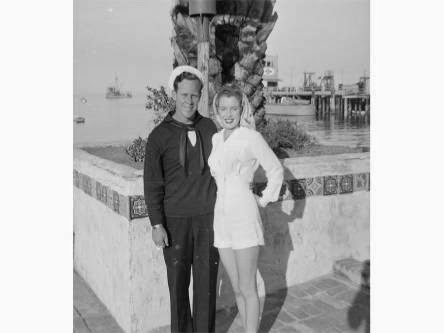
I'm reading an biography of Ronald Reagan by Edmund Morris. He was supposedly a long-time friend of Reagan, but the book reviews were mixed. However, one of the things he discusses that Reagan, who was at the time a sports reporter for the Des Moines Register, was sent to California to cover the Cubs spring training on Catalina (Wrigley owned the Cubs). He loved CA and couldn't believe there was no winter--he never looked back to Iowa. The book is dedicated to Christina Reagan--June 26, 1947,-June 26,1947, the daughter of Reagan and Jane Wyman. I'm not done with the book yet.
ReplyDeleteHi, Yes, he was mentioned in the Museum but it didn't have this story. I'm thinking that if I had been sent to Catalina at an early age, I might not have left CA either. My aunt and uncle moved here but my parents stayed in Iowa. Drat the luck. I could have been a CA girl like my cousins. We're on our way to Oceanside and San Juan Capistrano Mission, I suppose you'll tell us to eat at Ruby's. Isn't that where you and Ron ate?
ReplyDelete